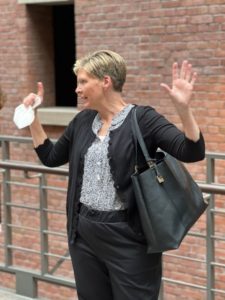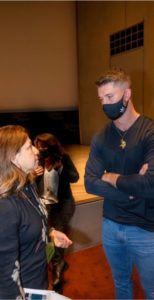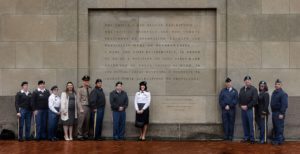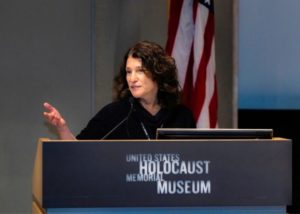WASHINGTON, D.C. — For the first time since 2019, more than 150 students, rabbis, teachers, and soldiers boarded a pre-dawn flight from Minneapolis-St. Paul International Airport to spend the day at the United States Holocaust Memorial Museum as part of the Jewish Community Relations Council of Minnesota and the Dakotas’ annual education trip.
“The trip is the culmination of all of the JCRC’s Holocaust education through the year,” said Laura Zelle, director of Holocaust education at the JCRC. “The basis in what people can’t dispute is so important with the backdrop of rising antisemitism. You can’t argue with these artifacts. To teach the historical truth is everything — it preserves our democracy.”

Educator Kristin Thompson talks to some of the JCRC visitors to the U.S. Holocaust Memorial Museum in Washington, D.C., on April 5, 2022.
Kristin Thompson, an educator who spent five and a half years training teachers in Holocaust education at the museum, said it’s important that visitors become witnesses to history.
“The responsibility falls to us,” she said.
Thompson led a small group through the permanent exhibit, which starts briefly on the liberation of the camps, but then quickly turns to talk about how Hitler and the Nazis rose to power.
“There was a slow loss of rights, and by the time people realized it, it was too late,” she said. “But when you see the propaganda, the book burnings, we don’t learn from history. That’s the part that is so upsetting.”
The trip is believed to be one of the few of this size and comprehensiveness, according to Alexis Schwartz, the director of the Jewish Federation of North America’s Civic Engagement Incubator, which helped support the trip.
“We are launching our new civic engagement incubator with the goal of fighting antisemitism and anti-Israel misinformation,” Schwartz said. “The JCRC used the funding to help expand what has been an already successful program of bringing Minnesotans to Washington, D.C. I’m so impressed with the way this community has been able to pull off an innovative experience for folks.”
Vikings connection

Laura Zelle, the JCRC’s director of Holocaust education, talks with Minnesota Vikings kicker Greg Joseph. (Ethan Roberts Photography).
Mark and Zygi Wilf are not just the owners of the Minnesota Vikings, they are the sons of Holocaust survivors whose names are on the wall as donors to the facility. They have actively supported Holocaust education globally and locally, with Mark Wilf leading a group of players on a tour of the museum in 2019. This year’s trip featured Minnesota Vikings’ placekicker Greg Joseph, his mother Illana, and Brett Taber, the Vikings VP of social impact.
Greg Joseph had been through the museum as a 7th grader, but this was his first time back in more than 14 years. He methodically walked through the permanent exhibit, reading as much as he could, but wasn’t ready to opine on any takeaways yet.
“Even though I’ve been here and been to many other museums, I’m so happy that the group is able to be here to learn, to expand their views on it, and to realize how possibly the most evil event in history happened with the most evil people behind it,” he said. “This museum does an amazing job of…illustrating it for us.”
Illana Joseph had never been to the museum, but as the dean of students for the Donna Klein Jewish Academy in Boca Raton, Fla., she has been on the March of the Living trip with her school’s senior class four times.
“As an educator, I’m passionate about educating kids on diversity, inclusion, whatever it takes. And the Holocaust is part of that,” she said. “As Jews, we have to remember so clearly where we came from in order to give these young kids a future.”
Joseph’s family immigrated from Europe to South Africa as the Nazis were coming to power. After growing up in apartheid-era South Africa, the family moved to Florida 20 years ago.
Taber went on the 2019 trip with Mark Wilf and the four players, and said that hearing the stories from the team owner was “incredibly impactful.”
“When you’re able to share personal, real-life experiences and stories, and connect it to the family, that made it even more powerful for the players,” he said. “It hits home when it’s genuine and authentic, coming from that perspective.”
Strong military presence
On this year’s trip, 12 Minnesota National Guardsmen and women took part in the experience — nine of them first-time visitors to the museum.

Members of the Minnesota National Guard stand outside the U.S. Holocaust Memorial Museum next to a famous quote from Gen. Dwight D. Eisenhower (Ethan Roberts Photography/JCRC)
Maj. Nathan Burr leads the Guard’s Holocaust special emphasis council, one of nine councils that the Minnesota National Guard offers.
“Our job is to remember, to educate, and to never forget what happened during the Holocaust,” Burr said. His interest in this area has to do with family history in the military, including a grandfather who served during World War II.
“We have 11,500 Minnesota National Guardsmen — Army and Air — and our goal is to reach every one of those someday with some sort of education about the Holocaust,” he said. “We do multiple events throughout the year, [but] this is kind of like our anchor. We pick individuals from across our formation, and then they are charged with going out and sharing their story with others in their unit.”
This trip to the museum is Burr’s seventh overall — sixth with the JCRC. In the past, leadership from the Guard and JCRC met with a member of Minnesota’s legislative coalition. This year, Burr, Army National Guard Col. Eduardo Suarez, and Air National Guard Maj. Corey Robinson, along with JCRC staffers Steve Hunegs, Ethan Roberts, and Anthony Sussman, met at the Pentagon with the Joint Chief of Staff of the National Guard Bureau — the highest-ranking officers in the National Guard.
“It went very well,” Burr said of the meeting. “We were able to highlight what our partnership with JCRC has done for outreach and education with the Minnesota Guard. It helps when they are developing policies to continue programs like the Special Emphasis councils, it helps when they’re working on budgets…and how that’s supporting not only individual states with the National Guard as a whole, [but] to continue to do efforts like this.”
Reflecting

Susie Greenberg, the associate director of Holocaust education at the JCRC, talks to the traveling group before starting the tour. (Ethan Roberts Photography.JCRC).
Waiting at the airport to head back to MSP, Susie Greenberg, the associate director of Holocaust education, said the impact on people is already being seen.
“I think the entire day is a reflection of how it has gone and what the impact is,” she said, based on the early returns from the evaluations. “From what I’m already seeing it is a great impact and a great educational opportunity that is not otherwise experienced. Coming to this museum, as we call it, the archive of memory of artifact and of testimony is kind of insurmountable.”
The experience bears an important lesson in the wake of rising antisemitism.
“The reason that the museum exists, and the reason that this is so important is to see the consequences of unchecked hate, bigotry, and antisemitism,” Greenberg said. “You can teach it, but to experience and to see and to listen and to watch and smell” brings a deeper understanding.
Said Zelle: “The day of the experience never gets old. You see new people interacting. It’s impactful and you see that impact. The logistics are tough; Susie works at it for months. The big picture of ‘why’ never gets old. It’s part of the mission of the JCRC and one of the most impactful things we do to fulfill the mission.”

















